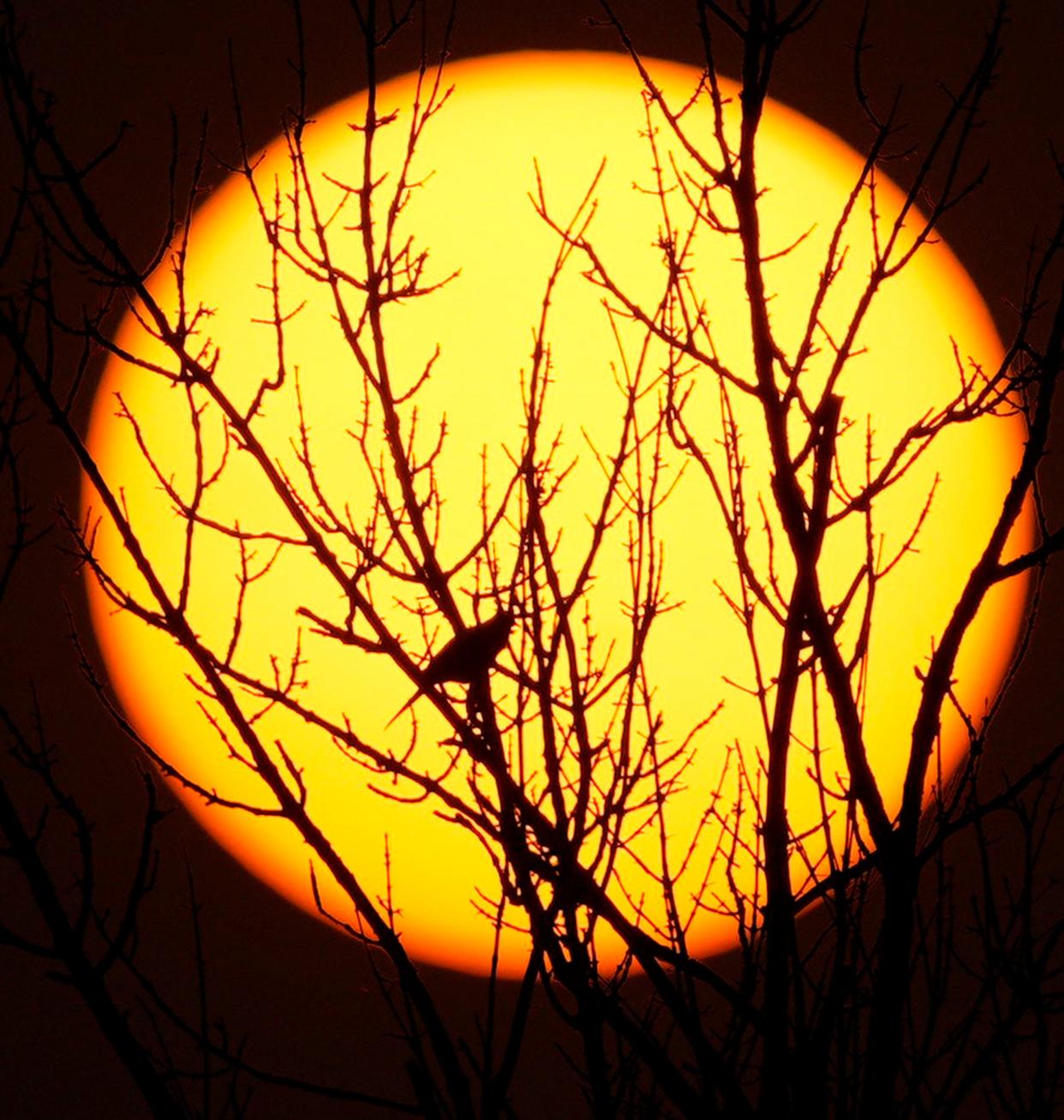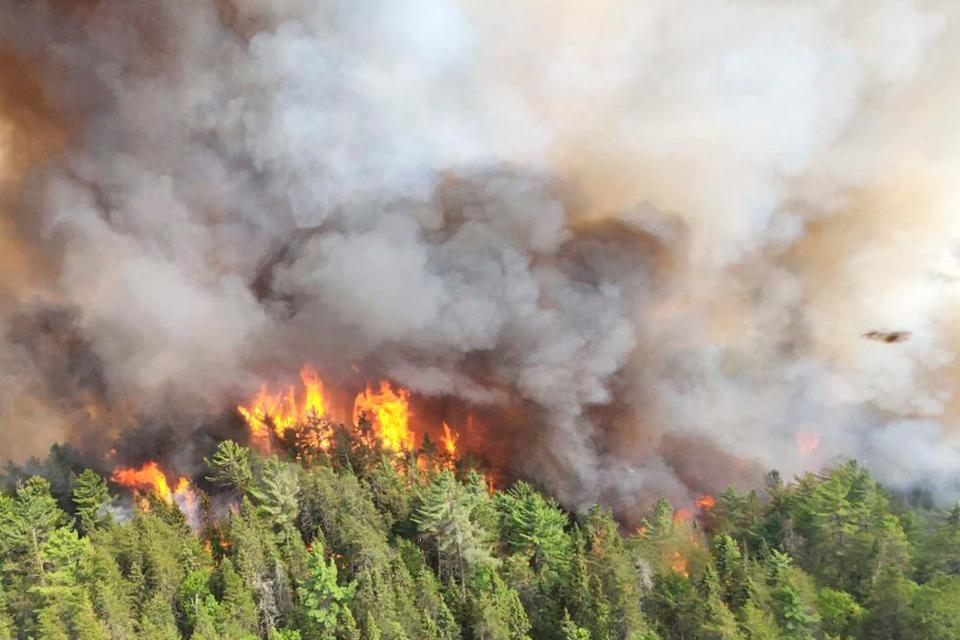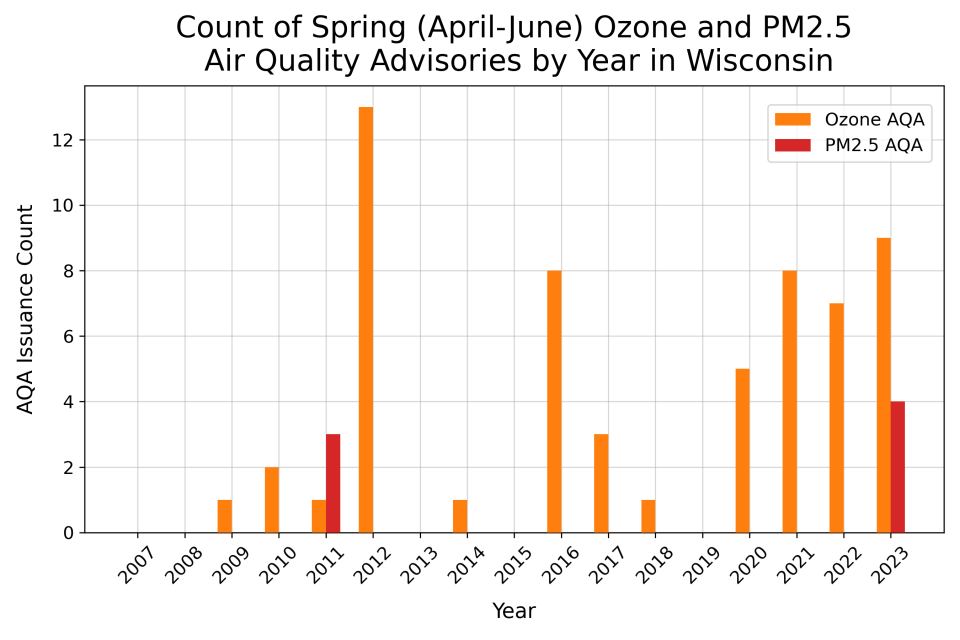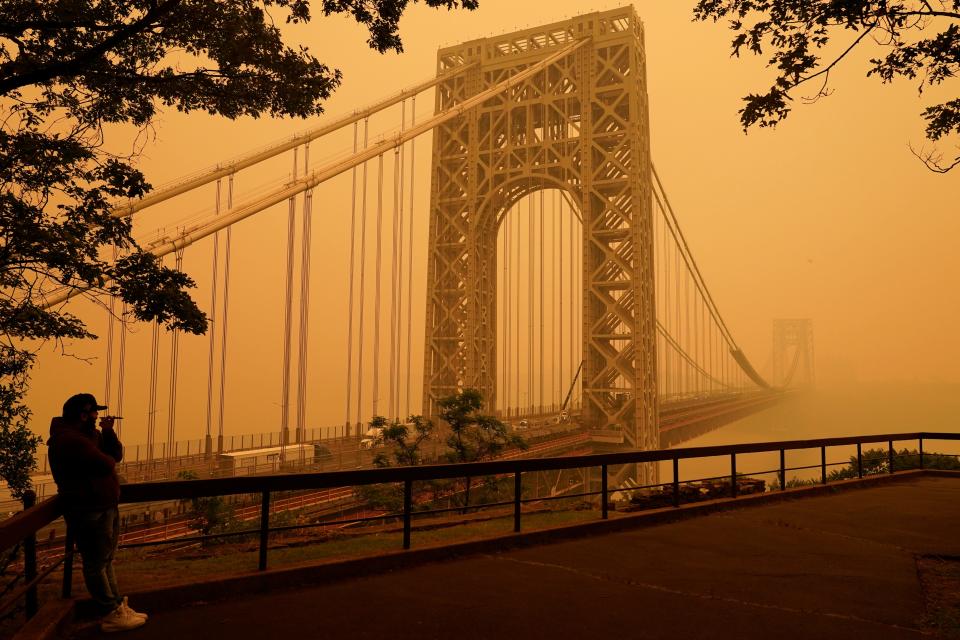'This is on our doorstep now': Wildfire smoke a reminder that climate change impacts human health

Smoke from Canadian wildfires that turned skies along the East Coast a sickly yellow has become yet another illustration of how changes in our climate foster extreme weather events.
In the last week, smoke from the same fires clouded skies in Wisconsin and caused a string of air quality alerts. The state health department cautioned people with heart and lung conditions to reduce outdoor exposure. In Brown, Eau Claire and Taylor counties, the air on Monday was briefly unhealthy for anyone to breathe.
The state Department of Natural Resources is on track to issue more air quality advisories this spring than any in the past decade.
In mid-May, sustained winds blew wildfire smoke in from the West, then a few slow-moving weather systems brought stagnant air that triggered ozone advisories, and most recently, winds from the east blew wildfire smoke from Quebec.
"It's been a very unique spring," said Craig Czarnecki, outreach coordinator for the DNR's air management program.
Climate experts contend, however, that as the planet continues to warm, this kind of spring will become less and less of an anomaly. In the process, air quality will continue to worsen and its impact on human health expand.
Fires have historically cropped up in the West, and wildfire scientists assumed the eastern part of the continent was immune from the effects, said Erica Smithwick, director of the Earth and Environmental Systems Institute at Penn State.
That's proving untrue.
Higher temperatures, periods of drought and more volatile winds are yielding wildfires that burn faster and stronger than before, Smithwick said. Wildfire season is also getting longer, as rivers in the West dry out sooner and the East sees stronger storms mixed with drought. Some scientists question whether the whole idea of a wildfire season still applies.
"I've studied wildfires for decades, and I'm quite alarmed by the changes that we're seeing to the wildfire systems," Smithwick said.
The severity of the fires is even affecting how far their smoke can travel. Smithwick said the stronger the blaze, the higher into the atmosphere the smoke can waft, being picked up by winds that travel long distances and ultimately push it into places it wouldn't normally go.

More: Wildfires in eastern Canada cause hazy skies, air quality alerts in Wisconsin. Here's what we know
Unhealthy ozone levels, stagnant air days increase in frequency
Fine particulate matter, also known as PM2.5, is one of the main pollutants released from wildfire smoke. This spring, Wisconsin has issued four PM2.5 advisories — the first time since 2011 that any have been issued in the spring.
And though Canadian wildfire smoke has dominated news, the number of ozone advisories Wisconsin's DNR has issued this spring is also higher than it's been in the last 10 years. In 2012, which Czarnecki called a particularly bad year for ozone pollution, 13 ozone advisories were issued between April and June. This year, there have already been nine. (The U.S. Environmental Protection Agency made its air quality standard for ozone more stringent in 2015, so Czarnecki said some increase in air quality advisories would be the result of that change.)

Ground-level ozone, a component of smog, forms when pollutants released by cars, power plants, chemical plants and other sources react with heat and sunlight. As the climate continues to warm, there will be more chances for unhealthy summertime ozone levels.
Hotter summers are also making stagnant air days more frequent, according to an analysis from Climate Central, a nonprofit news organization that analyzes and reports on climate science. During those stagnation events, pollutants like ozone get trapped and make breathing more difficult.
Poorer air quality means more respiratory, heart problems
Both fine particles from wildfire smoke and ozone can cause respiratory issues like coughing, difficulty breathing and aggravated asthma. People doing physical activity outdoors, particularly those who already suffer from respiratory problems, will usually find it harder to do.
On top of that, PM2.5 can have more dramatic effects because the particles are small enough to get deep into the lungs and even the bloodstream.

"Particulate matter is one of the most well-studied types of air pollution, and it is incredibly dangerous to the body," said Dr. Neelu Tummala, a clinical assistant professor of surgery and co-director of the Climate and Health Institute at George Washington University.
While short-term exposure typically results in respiratory concerns, chronic exposure brings worsening impacts like increased risk of heart disease, high blood pressure and stroke, Tummala said. For Black, brown and low-income communities, which already bear a higher burden of air pollution, the recent short-term exposures could further elevate their risk.
Both fine particle and ozone exposure can also result in pregnancy complications like pre-term births and babies with low birthweights, Tummala said.
And a 2021 study in the journal Pediatrics found that the particles in that smoke are 10 times more harmful to children's respiratory health than other types of air pollution. Smithwick, who is also a representative of the Science Moms campaign, said kids are vulnerable because they are more active, play outside more and are still growing.
"We're definitely going to be seeing this play out in our health systems for many years to come," she said.
Climate change will pose other threats to human health
Air quality isn't the only way humans will feel health impacts of the changing climate.
"Every year I hear in my clinic, 'This year feels like my pollen allergies are much worse,' or 'This year feels like the summer's really hot,'" Tummala said. "Without aggressive curbing of greenhouse gas emissions, there's going to be continued health impacts from these changes in the environment.
The Wisconsin Initiative on Climate Change Impacts' human health working group lists a suite of impacts that pose health risks. Communities of color, children, elderly people, pregnant people, lower-income households, people with disabilities and other historically underserved groups are more at risk.
Flooding and extreme precipitation events can cause injuries, infections and waterborne outbreaks.
Extreme heat can cause increased risk of heat-related death in certain populations, including the elderly.
A longer and more severe pollen season is making things tougher on those with allergies and asthma.
Hotter and wetter conditions can create more favorable conditions for the spread of Lyme disease and West Nile virus.
In each case, communities of color, children, elderly people, pregnant people, lower-income households, people with disabilities and other historically underserved groups are more at risk.
Beyond physical health effects, there are also mental ones — eco-anxiety, post-traumatic stress from living through intense weather events, and even financial struggles, as insurers stop issuing and renewing policies in disaster-prone states. Extreme heat in itself can increase rates of anxiety and depression, Tummala said.
The increasingly visible health effects make it a critical time to be taking action and making policy decisions about climate change, Smithwick said.
"We don't want our kids breathing this (smoke) in, we don't want to be breathing this in," she said. "This is on our doorstep now."
Madeline Heim is a Report for America corps reporter who writes about environmental issues in the Mississippi River watershed and across Wisconsin. Contact her at 920-996-7266 or mheim@gannett.com.
This article originally appeared on Milwaukee Journal Sentinel: Wildfire smoke shows climate change risks to human health

